Hurricanes - a threat to Atlantic shorelines and waterfront infrastructure
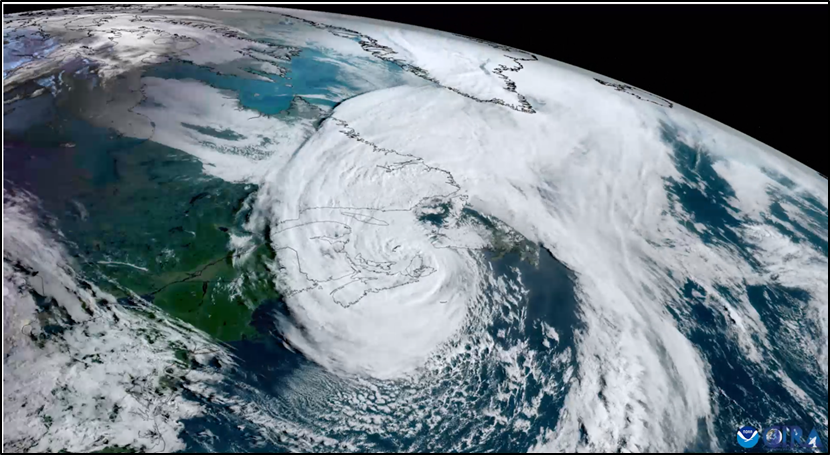
Hurricane Fiona over Atlantic Canada (CIRA/CSU & NOAA, 2022).
What are hurricanes?
Hurricanes originate in warm tropical waters, where an area of low air pressure and thunderstorms produces a tropical cyclone that then draws the warm water into the air. The intense winds and rain follow global oceanic currents up the Atlantic coast and are thought to move warm tropical air and water north, distributing that heat to the cooling northern climates. Hurricane force winds typically exceed 117km/hr, and can reach 250km/hr or more (Environment and Climate Change Canada, 2018)!
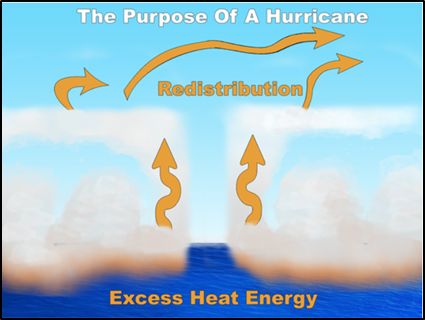
Hurricanes redistribute heat in the atmosphere. Credit: Environment Canada, 2009.
The word hurricane stems from the god “Huracan,” who was one of the earliest and most significant Mayan gods involved in the creation of the earth and humankind. Huracan was said to invoke the natural elements, such as rain, wind, and fire, and thus is closely tied with creation and destruction (Mayan & Tikal, n.d.). Later in Mayan mythology, Huracan became more closely associated with wind and storms. Due to the destruction Huracan wrought on the Mayans, the word Huracan morphed through various colonizer’s languages to “hurricane” in English; the root of the word meaning “evil spirit of the wind” (Admin, 2020).
Hurricanes Take Part in Natural Coastal Processes
“Beach erosion, dune movement, the opening and closing of inlets, and creation of overwash fans are phenomena that are part of the natural shoreline evolution, especially for barrier islands”
- Young et al., 1999
Many Atlantic coastal species are adapted to handle the occasional hurricane, and a variety of local flora species use these high winds as opportunities for broad seed dispersal (Belles, 2017). These storms can even act as natural selection forces, taking down flora growing in unfavourable or vulnerable locations (University of Rhode Island, 2020b).
Hurricanes move sediment (sand, pebbles, gravel) from beaches and coastlines and deposit it out at sea. Sediment deposition protects the shorelines from intense winter storms and stores the sediment during the winter so it can be redistributed onto the shore in the spring. Sediments can also replenish and strengthen barrier islands, which help to protect the coast from erosion and flooding during other storms (Belles, 2017). Additionally, sediments carried in the winds and waters of these storms help distribute nutrients to aid in the growth of new vegetation (University of Rhode Island, 2020a).
Hurricanes Threaten Shoreline Integrity and Infrastructure
No two hurricanes are alike (Mallin & Corbett, 2006), and for all the good a hurricane can bring to an ecosystem, it can also wreak havoc. Hurricanes can have a cascading effect of destruction, and with climate change boosting the intensity of hurricanes, there will be more frequent intense storms battering our shorelines (Mallin & Corbett, 2006). With all the excess leaf litter, organic material, and resuspended sediments entering the system due to wind and wave activity, the energy it takes to break these nutrients down causes a major decline in available oxygen – this condition is called hypoxia (University of Rhode Island, 2020a). Disturbance to our built environment such as wastewater treatment plants, farming operations, and electricity infrastructure can cause an additional influx of nutrients into the natural environment (called nutrient loading), which can, in turn, lead to eutrophication, harmful algae blooms, and anoxia (no available oxygen (University of Rhode Island, 2020a)) (Mallin & Corbett, 2006).
Eutrophication is the excessive growth of algae and plants in a system due to an overabundance of nutrients entering the system, often from human activity.
The major impacts a hurricane can cause to an ecosystem are storm surges (Canadian Red Cross, n.d.), saltwater inundation, waves scouring benthic/estuarine habitat, winds fluxing organic material and changing vegetation structure, extreme rainfall causing nutrient loading, and scouring floods (Patrick et al., 2020). Wind and waves are two erosive forces that can change the landscape drastically.
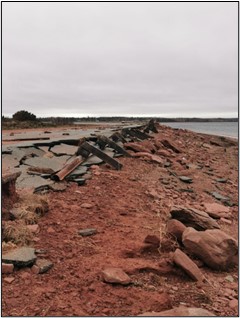
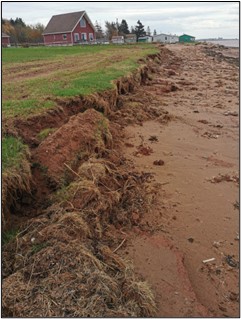
Prince Edward Island National Park (left) and the southern shore of Prince Edward Island (right) impacted by a hurricane in 2022. Credit: Kelly Umlah, TransCoastal Adaptations Centre for Nature-based Solutions.
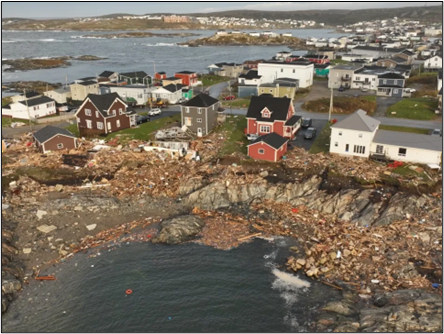
Port aux Basques damage after Hurricane Fiona in 2022. Credit: Yan Theoret/CBC.
Shoreline Resistance and Resilience to Hurricanes
Different elements of coastal systems respond differently to storms. For example, structural components, such as seagrasses, mangroves, or oyster reefs all have high resistance to storms, meaning it takes a lot more energy for a storm to damage them. However, if the storm does end up damaging them, it can take years – if not decades – for them to recover, making their resilience quite low (Patrick et al., 2020). Structural integrity of these ecosystem features promotes sediment accretion and shoreline stability, which supports recovery, but human-made issues like habitat fragmentation and small patch sizes make recovery more difficult (LTER, 2022). Indicators of coastal vulnerabilities to storms:
- Resistance = ability to remain unchanged by a storm
- Resilience = ability to return to pre-storm conditions
What level of resistance and resilience do you expect the coastal aspects below will have in response to a hurricane?
Resilient: Water chemistry would change rather quickly but can also change back once the disturbance ends (Patrick et al., 2020).
Resilient: Animals are able to hide or avoid storms and generally can survive well. Unless a hurricane occurs in the nesting season, nests of ground-nesting shorebirds may be vulnerable to damage from the storm. Recovery from the storm is generally quick, as long as food is available to them (Patrick et al., 2020).
Resistant: Salt Marsh grasses are largely resistant to physical impacts – their low stature, flexibility, and ability to lie flat minimizes the damage wind and rain can do.
Their resilience is limited to grow-back times if they are damaged, and if the structural aspects that keep them in place are damaged (i.e. a developed marsh platform), their grow back time is extended (Patrick et al., 2020).
Soils, especially along saltwater coasts, have a low resistance to salinity changes, as any saltwater inundation that seeps into them would drastically change the salinity of the soils.
Soil salinity has moderate resilience, as it can return to normal levels at a stable pace once the disturbance is over (Patrick et al., 2020).
Contrary to popular belief, sea walls generally only have some resistance to hurricane damage. While the structures themselves may hold in place, scouring, wave overtopping, and disturbed coastal processes all cause more damage to the area directly around the wall than there would be without the structure. This can cause the wall to become unstable, cracked, or to fail altogether (Truline,d.). Sea walls require human intervention to repair and are expensive to maintain, causing a barrier to their resilience.
How can you protect your property from hurricanes?
The application of Green Shores® nature-based solutions for shorelines helps mitigate the negative impacts of hurricanes and other shoreline risks to homeowners. While hurricanes might not be a threat to shoreline homeowners in British Columbia, it is a serious threat to shorelines in Atlantic Canada. Green Shores has a chapter in the Maritimes, coordinated by TransCoastal Adaptations: Centre for Nature-based Solutions. Learn more about Green Shores in the Maritimes here:
Admin. (2020). The True Meaning of Hurricane, History and Origin. Retrieved November 8, 2022, from True Meaning of Hurricane, History and Origin | Hurricane Facts
Belles, J. (2017). 5 things hurricanes can do that are actually good. The Weather Channel. Retrieved November 15, 2022, from 5 Things Hurricanes Can Do That Are Actually Good | The Weather Channel
Canadian Red Cross. (n.d.). Hurricanes: Information & Facts. Retrieved November 8, 2022, from Hurricanes: Information & Facts – Canadian Red Cross
Environment and Climate Change Canada. (2018). Learn about hurricanes. Retrieved November 8, 2022, from Learn about hurricanes – Canada.ca
Long Term Ecological Research Network (LTER). (2022). Ecosystems are Resistant or Resilient to Hurricanes, But Not Both. National Science Foundation. Retrieved on November 8, 2022, from Ecosystems are resistant or resilient to hurricanes, but not both – LTER (lternet.edu). IAS_1-20_ English (smu.ca)
Mallin, M.A., & Corbett, C. A. (2006). How hurricane attributes determine the extent of environmental effects: multiple hurricanes and different coastal systems. Estuaries and Coasts 29(6A), 1046-1061.
Mayans and Tikal. (n.d.). Huracan. Retrieved November 8, 2022, from Huracan – History of Ancient Mayan God Huracan a ‘Major God of Creation’ (mayansandtikal.com)
Patrick, C. J., Yeager, L., Armitage, A. R., Carvallo, F., Congdon, V. M., Dunton, K. H., Fisher, M., et al. (2020). A system level analysis of coastal ecosystem responses to hurricane impacts. Estuaries and Coasts 43, 943-959. Doi: https://doi.org/10.1007/s12237-019-00690-3.
Truline. (n.d.). Why do seawalls fail? Severe weather. Retrieved on November 29, 2022 from Why Do Seawalls Fail | Common Causes | TRULINE® Wall System
University of Rhode Island. (2020a). Aquatic Impacts. Hurricanes: Science and Society. Retrieved November 8, 2022, from Hurricanes: Science and Society: Aquatic Impacts (hurricanescience.org)
University of Rhode Island. (2020b). Terrestrial Impacts. Hurricanes: Science and Society. Retrieved November 8, 2022, from Hurricanes: Science and Society: Terrestrial Impacts (hurricanescience.org)
Young, R. S., D. M. Bush, A. S. Coburn, O. H. Pilkey, And W. J. Cleary. 1999. Hurricanes Dennis and Floyd: Coastal effects and policy implications. GSA Today 9, 1–6.





